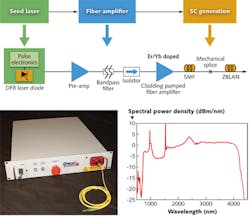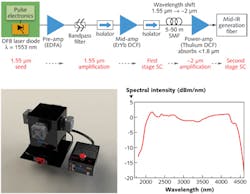SUPERCONTINUUM SOURCES: All-fiber designs extend supercontinuum sources into the mid-IR region
MOHAMMED N. ISLAM
Supercontinuum lasers combine the broadband attributes of lamps with the spatial coherence and high brightness of lasers. By exploiting a modulational instability initiated supercontinuum (SC) mechanism, an all-fiber-integrated SC laser with no moving parts can be built using commercial-off-the-shelf components.
Our team at the University of Michigan has developed and commercialized through Omni Sciences (both in Ann Arbor, MI) a mid-infrared SC laser (MISCL) that spans the 0.8–4.5 μm wavelength range. One version of this MISCL is based on an erbium/ytterbium power amplifier, while a second version is based on a thulium-doped power amplifier. The fiber laser architecture is a platform where SC in the visible, near-infrared (near-IR), or mid-IR can be generated by appropriate selection of the amplifier technology and the SC generation fiber.
The bandwidth of the SC laser is broad like a lamp, while the spatial coherence and high intensity or brightness of the output is like a laser, leading some to call the SC laser "the ultimate white light."1 But until now, SC lasers were used primarily in laboratory settings since typically large, tabletop, modelocked lasers were used to pump nonlinear media such as optical fibers to generate SC light. But now, those large pump lasers are being replaced with diode lasers and fiber amplifiers that gained maturity in the telecommunications industry.
By exploiting the natural physics of optical fiber, our group has made three major breakthroughs in SC lasers. First, we have extended the wavelength into the mid-IR region, ranging from approximately 0.8 μm near the edge of the visible spectrum, through the near-IR region from roughly 1–2 μm, and reaching most of the mid-IR region from approximately 2–4.5 μm. Second, we have eliminated the need for a bulky modelocked laser using telecommunications components. And finally, we can scale the power to 10 W or higher simply by increasing the repetition rate and using a high-power fiber amplifier, enabling practical commercial applications in defense, homeland security, metrology, and healthcare.
Modulational instability-initiated SC generation
Our all-fiber-integrated, high-powered MISCL light source is elegant for its simplicity (see Fig. 1). We start with a distributed feedback (DFB) laser diode with a wavelength near 1550 nm whose approximately 0.5–2.0 ns pulsed output is amplified in a multiple-stage fiber amplifier. The first stage pre-amplifier is a standard erbium-doped fiber amplifier (EDFA) designed for optimal noise performance. Between amplifier stages, bandpass filters block amplified spontaneous emission and isolators prevent spurious reflections. The power amplifier stage uses a cladding-pumped fiber amplifier that is optimized to minimize nonlinear distortion. This pump-laser configuration is a common and standard telecom design.
The SC generation occurs in the relatively short lengths of fiber that follow the pump laser. One or two meters of standard singlemode fiber (SMF) after the power amplifier stage are followed by several meters of SC generation fiber. In the SMF, the peak power may be several kilowatts and the pump light falls in the anomalous group-velocity dispersion regime-often called the soliton regime. For high peak powers in the dispersion regime, the nanosecond pulses are unstable due to a phenomenon known as modulational instability, which is basically parametric amplification in which the fiber nonlinearity helps to phase match the pulses.2 As a consequence, the nanosecond pump pulses are broken into many shorter pulses as the modulational instability tries to form soliton pulses from the quasi-continuous-wave background.
Although the DFB laser diode and amplification process starts with nanosecond-long pulses, modulational instability in the short length of SMF fiber forms approximately 0.5 ps to several-picosecond-long pulses with high intensity. Thus, the few meters of SMF fiber results in an output similar to that produced by modelocked lasers, except in a much simpler and cost-effective manner.
The short pulses created through modulational instability are then coupled into a nonlinear fiber for SC generation. The nonlinear mechanisms leading to broadband SC include four-wave mixing or self-phase modulation along with the optical Raman effect.3 Since the Raman effect is self-phase-matched and shifts light to longer wavelengths by emission of optical phonons, the SC spreads to longer wavelengths very efficiently. The short-wavelength edge arises from four-wave mixing, and often the short wavelength edge is limited by increasing group-velocity dispersion in the fiber. In our experience, of the particular fiber used for sufficient peak power and SC fiber length, the SC generation process will fill the long-wavelength edge up to the transmission window.
Mature fiber amplifiers for the power amplifier stage include Yb-doped fibers (1060 nm), Er/Yb-doped fibers (1550 nm), or Th-doped fibers (2000 nm). Other candidates for SC fiber include fused silica fibers (for generating SC between 0.8 and 2.7 μm), mid-IR fibers such as fluorides, chalcogenides, or tellurites (for generating SC out to 4.5 μm or longer), photonic crystal fibers (for generating SC between 0.4 and 1.7 μm), or combinations of these fibers. By selecting the appropriate fiber-amplifier doping and nonlinear fiber, SC can be generated in the visible, near-IR, or mid-IR wavelength region.
MISCL performance
Our Gen I MISCL uses an Er/Yb-doped fiber amplifier for the power amplifier and a ZBLAN fluoride fiber for 3.9 W average-output-power SC generation (with a 50% duty cycle modulation) from approximately 0.8–4.3 μm (see Fig. 2). Because the broadband spectrum emerges at the output of a singlemode fiber, the entire spectrum emerges in a spatially coherent, nearly transform-limited beam that can propagate for long distances. For example, beam propagation for a Gen I MISCL over the wavelength range from 2.5–3.5 μm is within 20% of a transform-limited Gaussian beam (m2 <1.2).The MISCL output power can be varied by changing the system repetition rate. In the Gen II MISCL we varied the system repetition rate between 125 and 500 kHz and were able to change the mid-IR output power between 0.4 and 1.6 W, respectively, with a very similar output spectrum.
MISCL applications
In defense and homeland security applications, the MISCL spectrum emulates the blackbody radiation of hot objects and overlaps with the vibrational and rotational resonances in many solids. For example, most heat-seeking missiles target the heat of the engine, which has a spectrum from roughly 1.5–5 μm, allowing the MISCL to be used as a light source in directed IR countermeasure (IRCM) systems that, unlike most other lasers, cannot be defeated by using filters.5
Many solids, including explosives and firearms, have distinct spectra over the near- and mid-IR wavelength ranges, allowing the MISCL to be used in spectral fingerprinting to examine the pattern of spectral lines-rather than only one or two lines-for standoff detection of solid targets with diffuse reflection spectroscopy.6
The MISCL's broadband spectrum is also advantageous in metrology applications. Broad spectral width permits precise depth spatial resolution, and the spectral dependence of reflected light can be used for measuring properties of a surface such as surface roughness. We have used a visible SC laser to obtain 3D images of solder balls on a semiconductor die with 125 nm axial and 15 μm lateral resolution.7 For a different application, a near-IR MISCL performed high-accuracy, noncontact roughness measurements of flat and curved machined parts in automotive powertrain systems over the industrially relevant range of 0.05–0.35 μm.8
For medical diagnostics and therapeutics in healthcare applications, the carbon-hydrogen bonds that are the main building blocks of lipids (fat, cholesterol, fatty acids) have their fundamental vibrational and rotational bonds between 3.3 and 3.6 μm, which fall nicely within the MISCL wavelength range, allowing it to be used as a source for absorption spectroscopy of the constituents of normal artery and atherosclerotic plaque, including adipose tissue, macrophages, and foam cells.9 By using a MISCL in the carbon-hydrogen fatty acid and cholesterol esters absorption wavelength, we can demonstrate differential damage of lipid-rich adipose tissue without damaging the protein-rich blood vessel wall. Given the widespread healthcare problems with obesity and cardiovascular disease, there are bound to be many further healthcare applications arising in the future.
The simple MISCL design produces broadband output in a nearly transform-limited, spatially coherent output beam that lends itself to novel applications now and in the future. As telecom components and pump laser diodes scale up in power, so too will the output from SC lasers-scaling up to 10 W and more.
ACKNOWLEDGMENT
The work has been sponsored in part by Army CERDEC, NAVAIR, Air Force, DARPA, and Omni Sciences.
REFERENCES
1. R.R. Alfano, Sci. Am., 86-93 (December 2006).
2. M.N. Islam, Ultrafast fiber switching devices and systems, Cambridge University Press, New York, NY (1992).
3. C. Xia et al., IEEE J. Sel. Top. Quant. Electron., 15, 2, 422–434 (2009).
4. O.P. Kulkarni et al., J. Opt. Soc. Am. B, 28, 10, 2486–2498 (2011).
5. C.Q. Choi, Sci. Am., 30 (November 2010).
6. M. Kumar et al., "Stand-off detection of solid targets with diffuse reflection spectroscopy using a high power mid-infrared supercontinuum source," submitted to Appl. Opt.
7. M. Kumar et al., Opt. Exp., 18, 21, 22471-22484 (2010).
8. V.V. Alexander et al., Opt. Eng., 50, 11, 113602-1 to -11 (2011).
9. K. Ke et al., Opt. Exp., 17, 15, 12627–12640 (2009).
Mohammed N. Islam is a professor in the Department of Electrical Engineering and Computer Science at the University of Michigan and in the Department of Internal Medicine, Division of Cardiovascular Medicine, at the University of Michigan Medical School, and founder and CTO of Omni Sciences, 9477 N. Territorial Road, Suite 120, Dexter, MI 48130; e-mail: [email protected]; www.omnisciinc.com.


